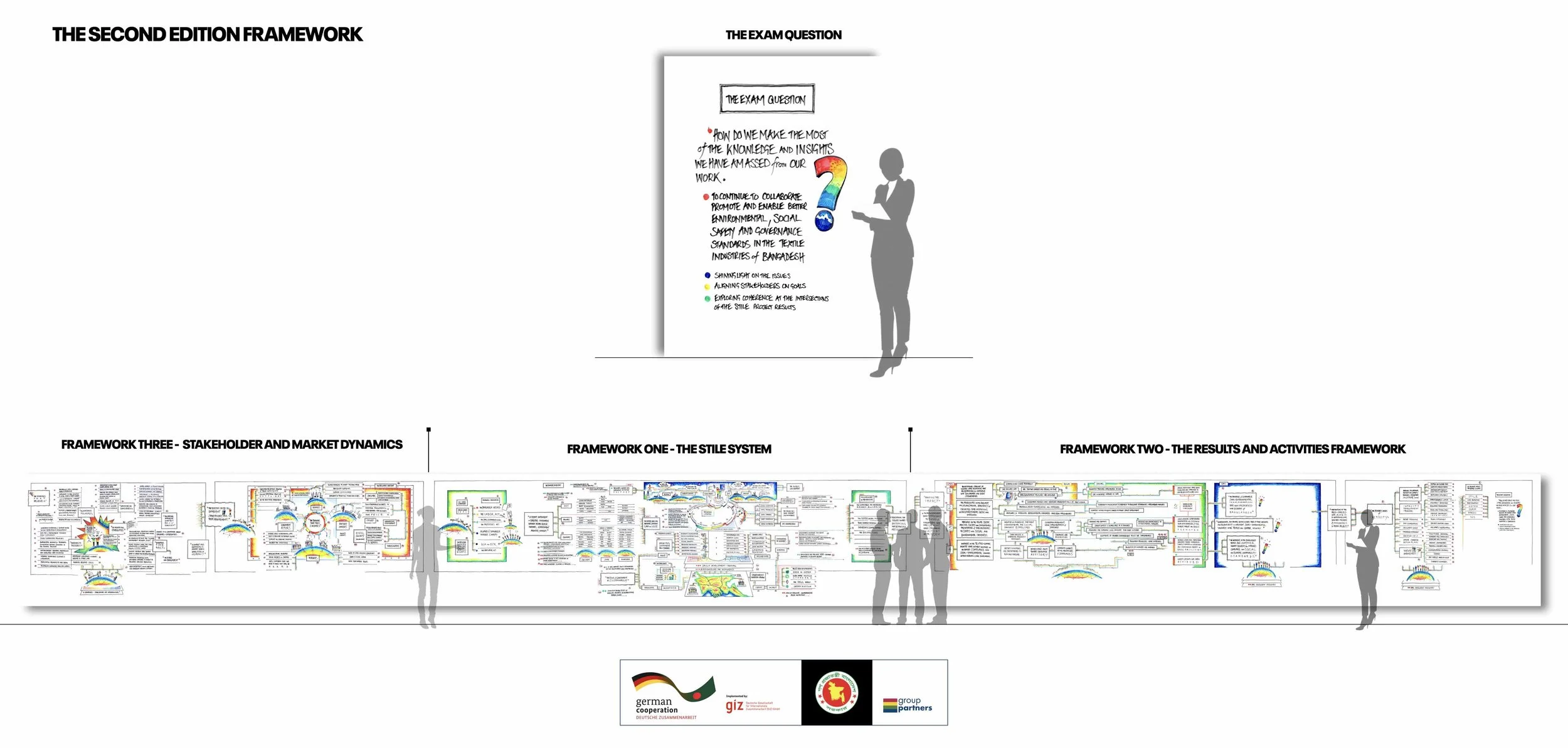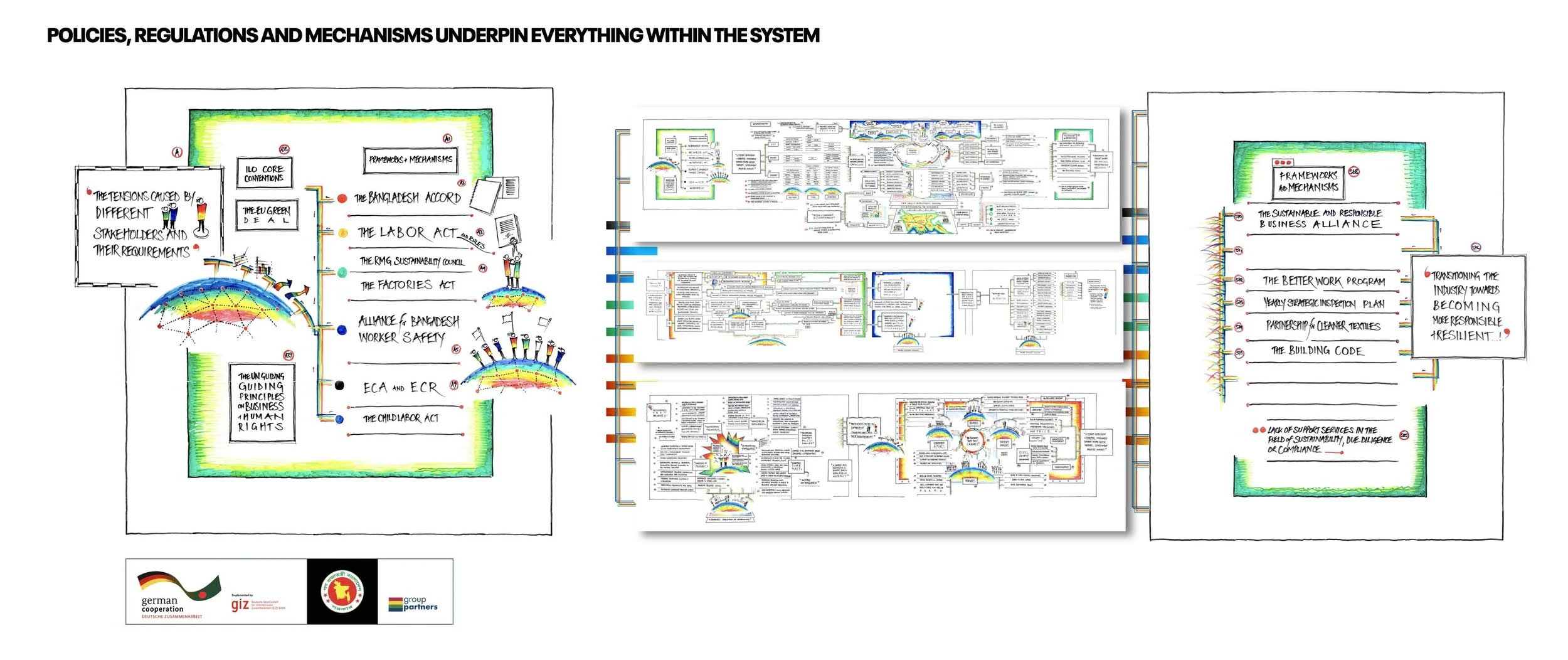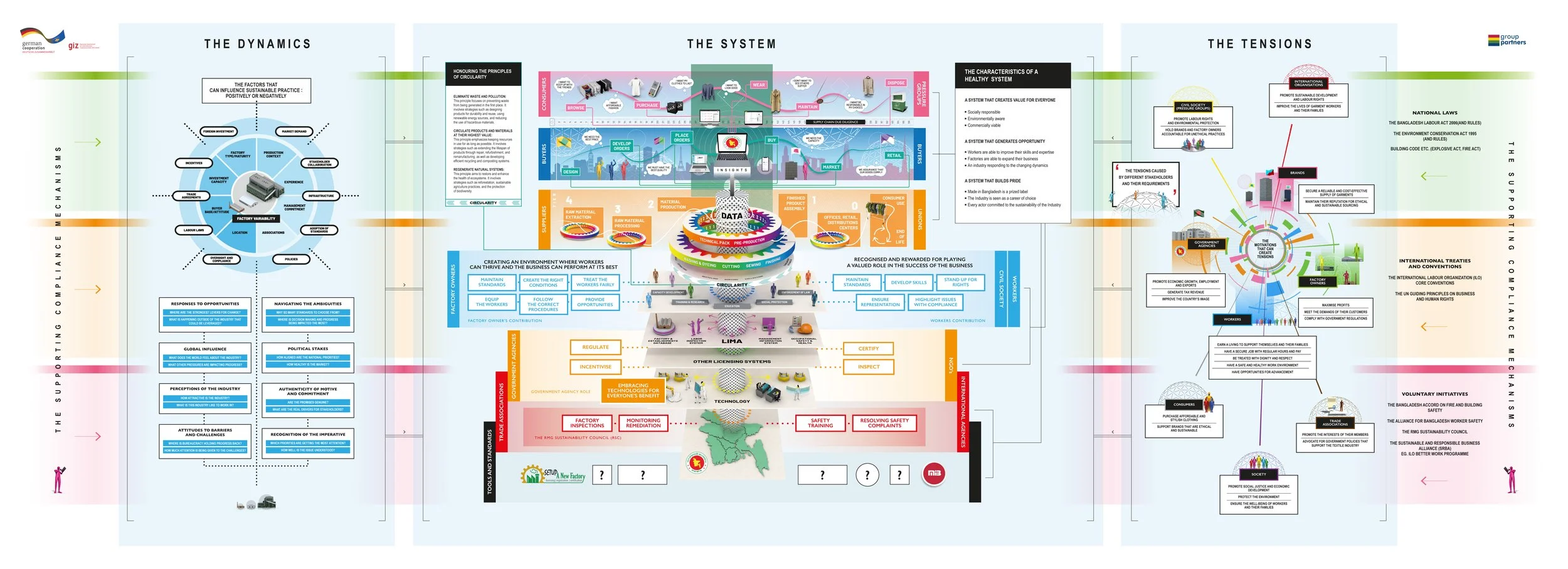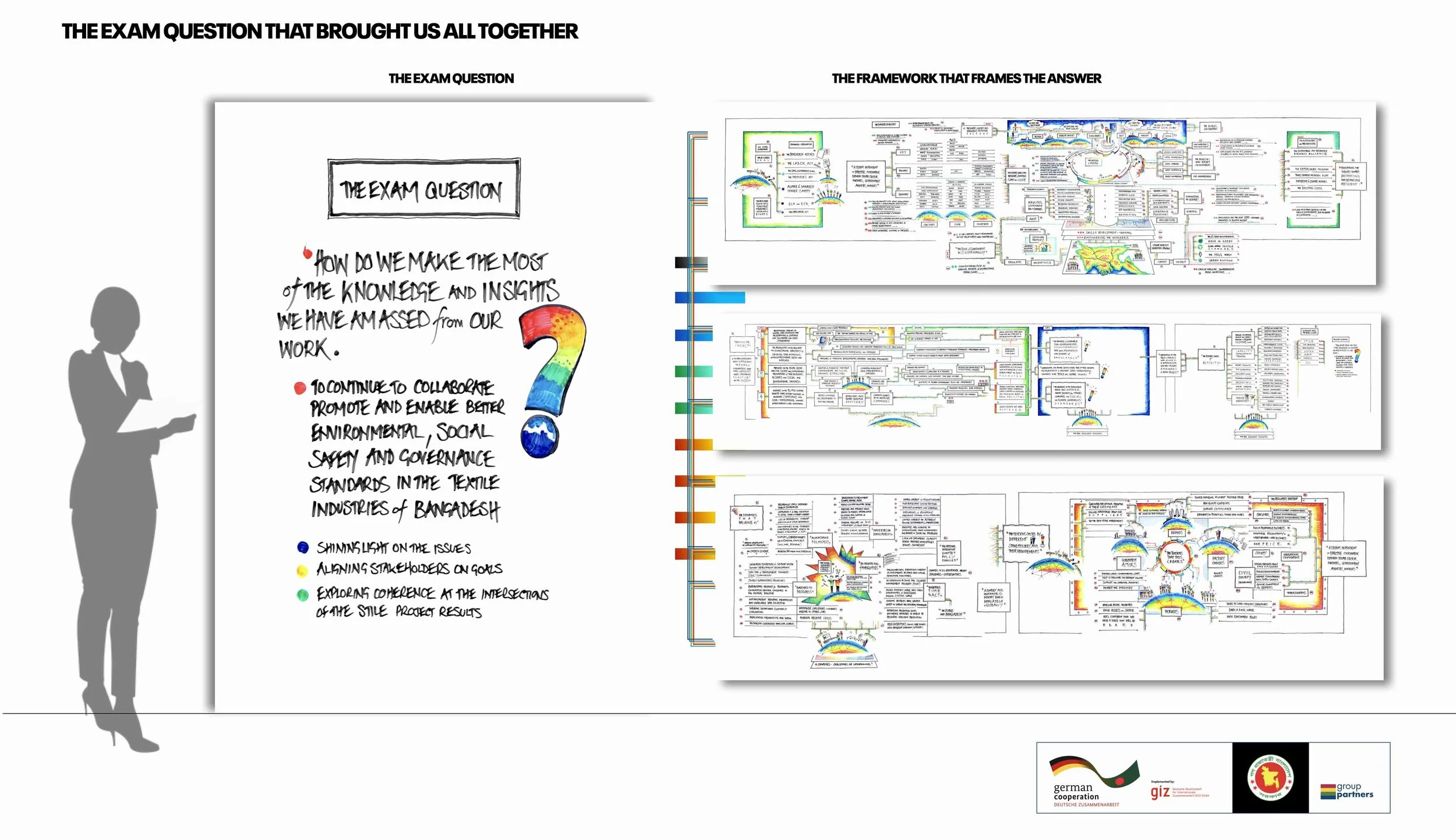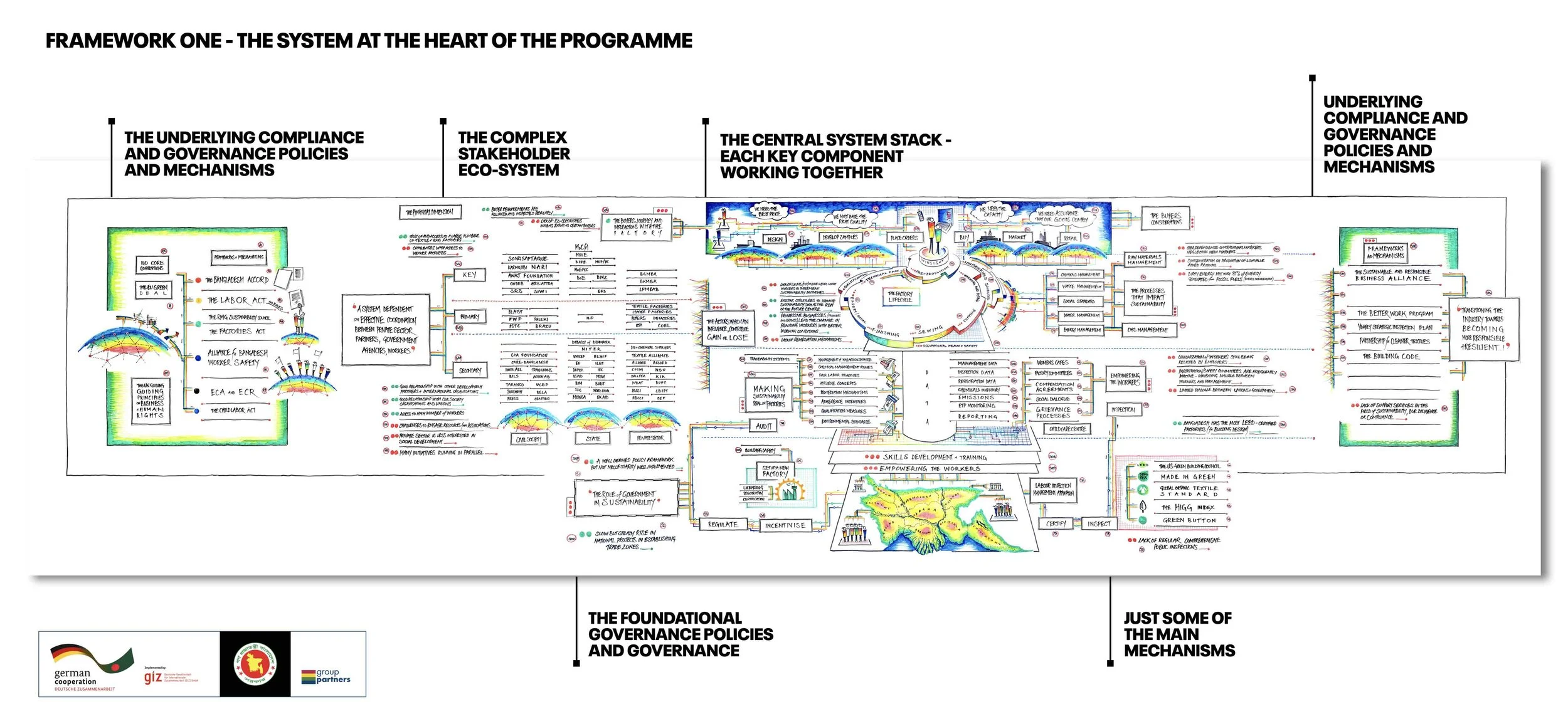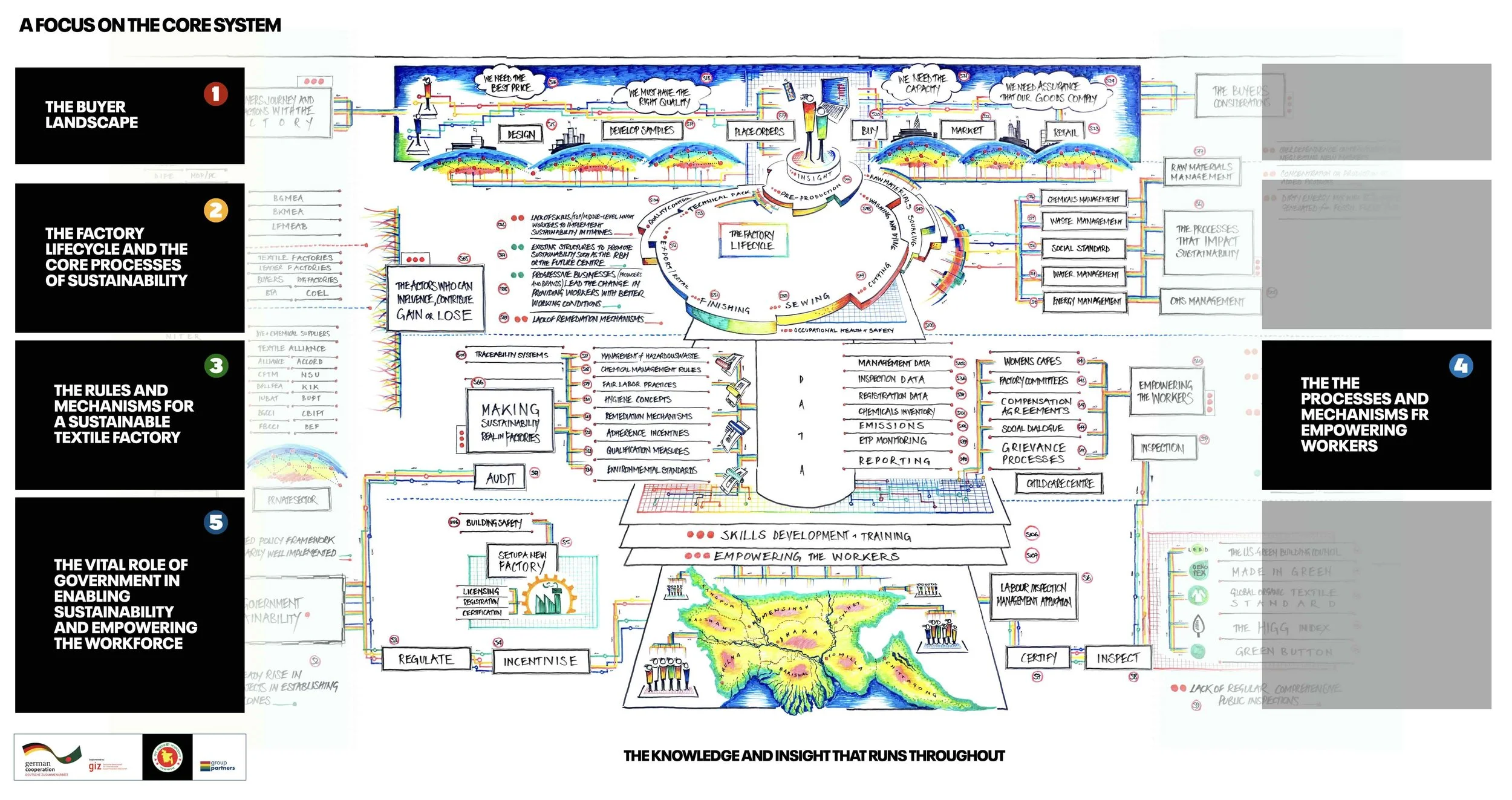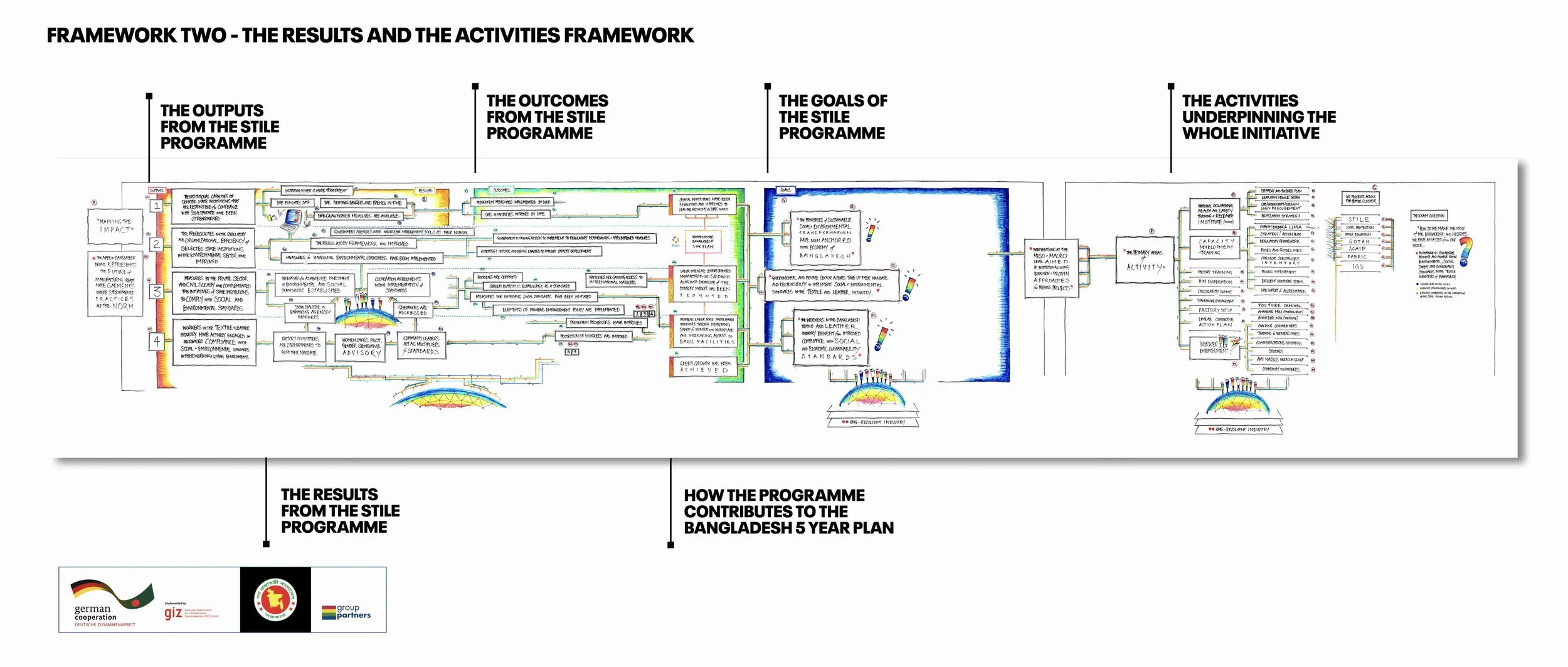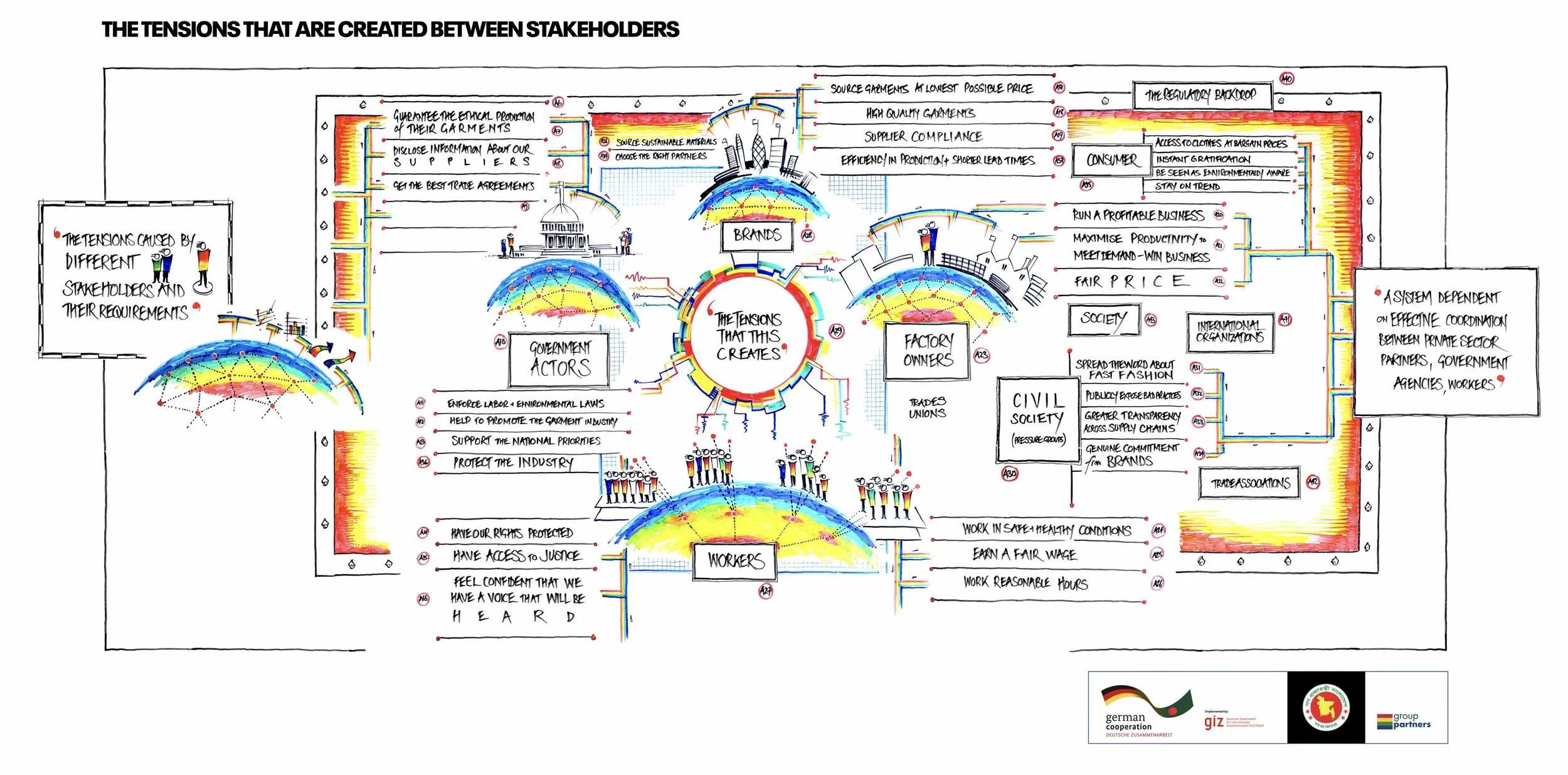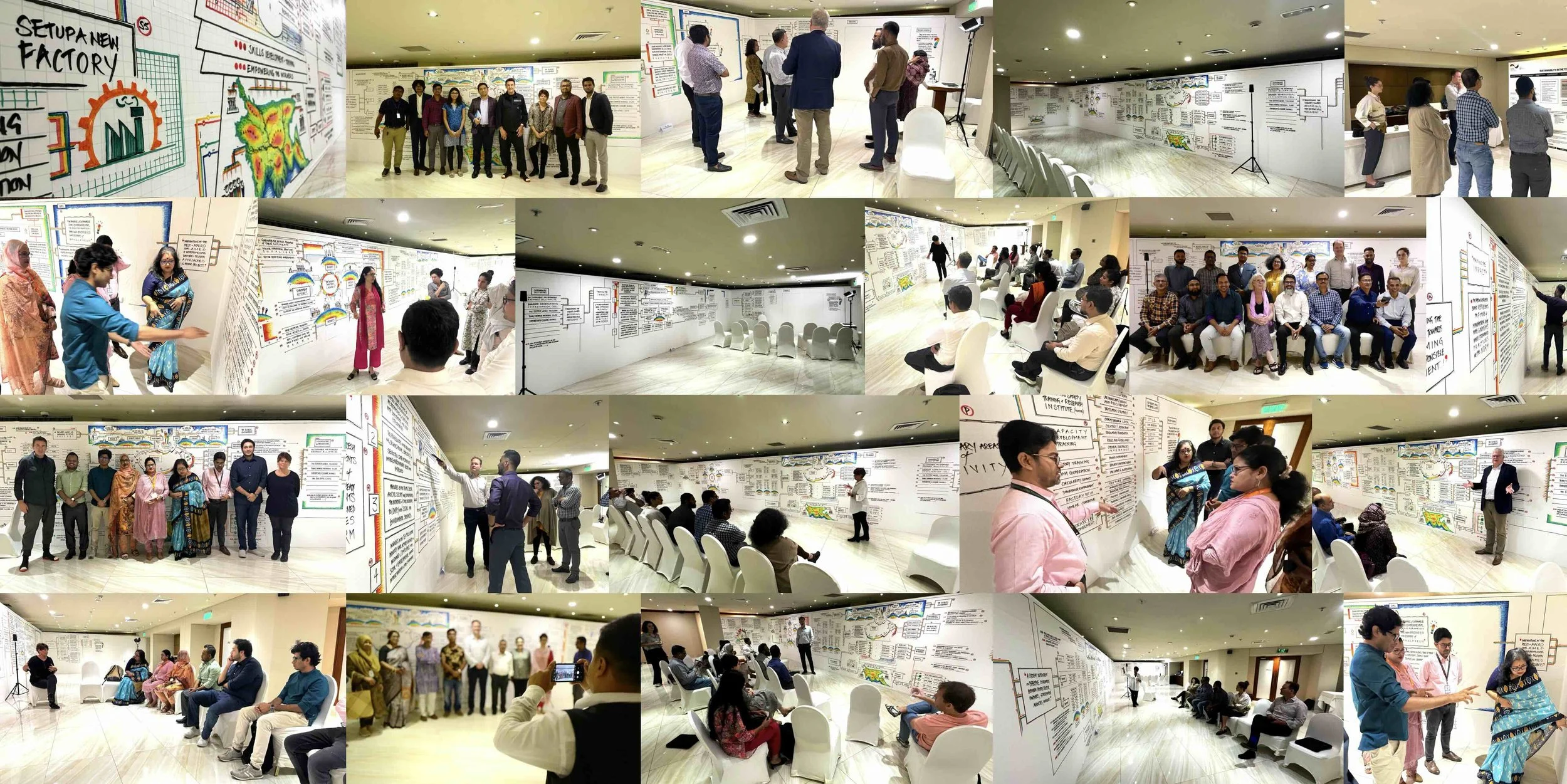
The First Edition
We described the ‘first edition framework’ as a moment in time and beneficial context to bring into the room during the week. It was a helpful backdrop.
This first edition was focused primarily on the exam question and the context within which that exam question exists. It helped us to get a better sense of the aims of the program and the context within which all the work was being undertaken.
NB: Because of the room's acoustics, the videos benefit from using Captions to help the explanations.
Download High Resolution Versions At The Link Provided
As you can see from the image, many components need to be considered to do justice to the amount of information and knowledge held by the STILE team for this industry, reflecting the importance of that knowledge in building solid foundations for achieving important objectives.
The Second Edition
The second edition is a reflection of building a deeper appreciation of the program and the industry. The week in Dhaka was spent building further alignment and accuracy by engaging with a diverse mix of important stakeholders to ensure that the system is representative of many perspectives and useful to highlight where the knowledge is and how that knowledge is important in delivering a hyper-performing, safe and fair textile industry in a highly complex environment.
Download High Resolution Versions At The Link Provided
It is important to note that these frameworks were deliberately designed to be added to.
To allow further input from everybody in the room, considerable insights and additions emerged over the week. We deliberately avoided further overwhelming the frameworks with even more detail. We will continue to develop visuals that do justice to the many insights and interdependencies while making them useful, practical devices.
Think of the ‘headline boxes’ (the larger ones) as ‘double clicks’ to further detail in the sense of a digital/mobile application.
Download High Resolution Versions At The Link Provided
It is also important to note that policies, regulations, governance frameworks and mechanisms underpin everything. They are behind everything. We have positioned some to either side of each framework - particularly the green boxes in the system and the stakeholder tension framework.
This is not a complete list. They are a crucial underpinning of the entire system, providing the guiding principles, rules, regulations, policies, voluntary initiatives and conventions that are at the heart of ensuring a sustainable future for the textile industry in Bangladesh.
For example - the Labour Act, the ILO, convert core conventions, the EUGreen deal, and the UN guiding business and human rights principles. The ECA, ECR, the Bangladesh Accord, the Factories Act, and the RMG sustainability council.
We will be updating this list as we move into the third edition.
The Third Edition
The Third Edition - a refined and updated ‘digital’ version of the work we all did together.
To us, frameworks are living things, they can act as helpful tools for a long time but will need updating as the program evolves into the next stage.
The Exam Question
What guided all of our work together was the ‘exam question’.
The exam question is a device that anchors everything. The question that needs answering, and we answered it in collaboration with the three frameworks we explain below.
Our exam question:
“How do we make the most of the knowledge and insights we have amassed from our work? - To continue to collaborate, promote and enable better environmental, social safety and governance standards in the textile industries of Bangladesh.”
To shine a light on the issues throughout the influencing systems. Align stakeholders on the strategic goals for sustainability in this and adjacent sectors. And explore the coherence and intersections of the style project results.
The primary goal of the STILE program is that the Bangladesh textile and leather industry workers benefit from improved compliance with social, ecological and economic sustainability standards.
The Main Frameworks
In the room, three main frameworks were displayed.
Right at the heart sits the system.
The activities, results, goals, outcomes and outputs are on the right-hand side of the system, which will help to introduce greater compliance.
And to the left of the system—the existing stakeholder tensions and dynamics that we all need to understand as we develop solutions and new strategies for compliance.
Download High Resolution Versions At The Link Provided
Explaining The System Framework.
Download High Resolution Versions At The Link Provided
Three Red Dots - Main Heading
Two Red Dots - Weakness
Two Green Dots - Strength
The Central Section
Explained from top to bottom.
The buyer's journey explains the critical moments in the world of the brands. In these moments, brands make buying decisions that lead (ideally) to business for Bangladesh. We included some examples: they need the best price, the right quality, the capacity they need, and assurance that their goods will comply.
Download High Resolution Versions At The Link Provided
In the centre of the system - at the top, the buyer’s world suggests a seamless flow of interaction and support to and from the factory. This is a significant intersection where insight into what buyers and factory owners need is essential. The factory must understand how to provide that service most effectively and efficiently and in ways that comply with the requirements of a fair and sustainable system at a viable (acceptable to all) cost.
Our challenge is to do all this without exploiting the worker or the environment. There is a lot at stake with people mostly living on a minimum wage. And even that isn’t being enforced everywhere. Add to that the enormous pressures and effects on the environment and the region rapidly approaching critical as we witness the significant effects of climate change.
At the top is the factory life cycle, explaining how products and goods are made locally in Bangladesh and delivered to the right quality based on systems that will impact sustainability.
Throughout this systemic view is a data pillar which starts to define the different types of data necessary to ensure the processes, systems, and mechanisms on the left that make sustainability real in the factory are in place and working consistently as needed.
The processes, systems and solutions will empower the workers on the right.
The detail from each of these key areas is shown in the representation.
Supporting all of this is the primary objective of the STILE program to create sustainable industries, empowering the workers by integrating the policies, frameworks and mechanisms of governance that will make a sustainable industry, a resilient future and the goals and objectives as stated.
System Details
The Factory Life Cycle.
The preproduction phase, the identification and sourcing of raw materials, the washing and dying (that may happen locally), cutting, sewing, finishing, and finally, export and retail. All underpinned by quality control and the processes that should be designed for the business to operate sustainably.
These include all the essential processes that control materials management, OHS management, chemicals management, waste management, social standards, water management and energy management. We will refine the set in the next edition to take in the inputs we received.
Download High Resolution Versions At The Link Provided
Making Sustainability Real In Factories.
We focused on areas we knew were particularly relevant to STILE’s work - Traceability systems, hazardous waste management, chemical management rules, fair labour practices, hygiene concepts, remediation, mechanisms, adherence, incentives, qualification, measures and environmental standards.
Empowering The Workers
Ultimately, this needs to cover everything related to Social protection and the empowerment of workers to make this industry sustainable.
We noted some examples:
Workers Cafes, factory committees, compensation, agreements, social, dialogue, grievance, processes and childcare centres.
The Data Pillar.
Managing all data - for example, inspection data, registration data, chemicals, inventory, emissions, ETP, and subsequent monitoring and reporting.
Download High Resolution Versions At The Link Provided
At the foundation (the bottom) of the central image sits the role of Government in sustainability, showing how they regulate, incentivise, certify and inspect the factories, the supply chain, the import and export of raw materials and much more.
Government has an essential role in the governance and compliance of every industry and is central to the long-term sustainability and resilience of the textile industry.
To the right of this are examples of frameworks and mechanisms - such as the building code, the better work program, the partnership for cleaner textiles, the yearly strategic inspection plans, the sustainable and responsible business alliance and more. (See also the third framework to the left.)
To the left are the key primary and secondary actors across civil society, the state and the private sector, all contributing in different ways and points across the system. These important actors/stakeholders can influence and contribute (gain or lose) to our aim—to achieve the most sustainable result for the textile industry.
Download High Resolution Versions At The Link Provided
Mapping The Impact - Framework Two
SUBTITLES - Please use Closed Captions: CC at the navigation bar to see subtitles on each video.
The outputs, outcomes and goals explain the immediate results framework for the style program.
The four outputs explain clearly how compliance efficiency and initiatives will have improved the circumstances for the workers by strengthening, enhancing and increasing compliance based on social and environmental standards throughout the system.
Download High Resolution Versions At The Link Provided
The STILE Activities
This framework describes the main activities and the initiatives underway that are contributing to the program so far.
The main focus areas have been workers empowerment, capacity development and training, national occupational health and safety training and the research institute, factory training, H&M cooperation, the circularity summit stakeholder engagement factory setup and the LFMEAB corrective action plan.
The External Factors - Framework Three
The Tension That This Creates
As mentioned, the left-hand framework was about stakeholders, their interdependence and inevitable conflicts. Much of it is out of our direct control, in the sense that tensions arise when individual stakeholders have different motivations and requirements as a natural part of their focus and interests in the industry. Understanding those tensions helps us to design the right processes and mechanisms.
Download High Resolution Versions At The Link Provided
This framework shows a series of worlds.
These worlds are naturally unique to each stakeholder, they display how contradictory intentions, drivers and motivations exist and need to be understood so that the right decisions are made at various points across the system.
The picture represents four globes on the left-hand side, and a further six were added during the week. Between the government, the brands, the factory owners, the workers, civil society and society in general, the consumer, the international organisations, the trade associations, and the trade unions we have many different factions that are typical in every industry and where we need to find mutual value and cooperation.
The industries that are successful and sustainable into the future recognise the existing tensions and work together to build plans and strategies to deal with them.
Download High Resolution Versions At The Link Provided
The Dynamics
Dynamics influence us. We can use them to our advantage or ignore them, but if we do (ignore them), they may harm our endeavours.
This image is structured into six main areas at present. There will be more in the third edition. We distilled them into these areas, primarily based on the opportunities and threats analysis that is currently underway. We felt that this 6 was a good representation to get us started.
There’s a lot at stake politically. There are many eyes in Bangladesh right now. The national imperative is not yet fully realised. There are barriers to progress, But there’s no better time to act. And right in the middle. We are in an industry that is full of ambiguities.
As you read these lists, they are well-recognised and familiar aspects of the industry and many of them factor into the decisions that are made every day.
Many will continue to frustrate all stakeholders in their operations daily, and many will be necessary to leverage as the program evolves and the stakeholders overcome the challenges inherent within them.
Download High Resolution Versions At The Link Provided
The Dynamics That Influence Us
There’s A Lot At Stake Politically
Rise from LDC status increases the need for compliance
Compliance is a pre-condition to RMG export in target markets
Loss of preferential market access to a lot of export destinations (EU)
Cash incentives by the Government for the textile industry have to be reduced in the context of GSP
Volatility of garment markets due to external factors (Covid, War, Economy)
There’s Many Eyes On Bangladesh
Bangladesh is a prominent climate change victim
Textile is a highly polluting sector
Pressure and interest from brands to address informal waste collection and sorting of textile scrap
External pressure on improvement of labour rights (e.g. U.S.)
The country is facing severe problems with good governance.
The National Imperative Is Not Yet Fully Embraced
Limited interest in product diversification
More textile waste could be used for recycling
Employer commitments can be superficial
Implications of adopting international standards not fully appreciated
There’s limited interest in actively promoting sustainability on the factory level
Factories are looking to International donor communities and brands to solve the problem
Lack of strategic clarity within partner ministries affects ownership
The Barriers To Progress
Unhealthy competition for similar work (between Development Organizations)
The slow pace of Bangladesh towards SDG/sustainability
Complex bureaucratic processes
Bureaucratic obstacles to Technical Cooperation remain unsolved in the Political Dialogue.
Intransparent reporting mechanisms and unreliable data collection
Importing second-hand clothing is challenging
Participation mechanisms are still weak
There’s No Better Time To Act
The country will eventually diversify its investment in other high-value-generating industries.
An opportunity to solve the Sludge-Management Problem (TSDF)
Higher Minimum wage will open opportunities for discussion around the Living Wage
On-going projects from UNIDO/UNDP to support the circularity framework
Increasing production costs encourage factories to invest in resource-efficient production
A Collective Endeavour
Appendices
The Strengths And Weaknesses Across The System
Buyer requirements are followed and inspected regularly (Strength)
Lack of ISO-Certificates inhibits export to certain buyers (Weakness)
The trust of and access to a large number of textile and RMG factories (Strength)
Challenges with access to weaker factories (Weakness)
Good relationship with other development partners and international organisations (Strength)
Good relationship with civil society organisations/unions (Strength)
Access to a high number of workers (Strength)
Challenges to actively engage resources from associations (Private Sector/ Key)(Weakness)
The private sector is less interested in social development (Private Sector) (Weakness)
Many initiatives running in parallel (Civil Society) (Weakness)
Lack of support services in the field of sustainability/due diligence/compliance (Weakness)
Over-dependence on traditional markets – neglecting new markets (Weakness)
The concentration of production on low-value-added products (Weakness)
"Dirty” energy mix with 85% of energy generated from fossil fuels (Energy Management) (Weakness)
Existing structures to promote sustainability, such as the RBH or the Future Centre (Strength)
Progressive businesses (producers and brands) lead the change in providing workers with better working conditions (Strength)
Lack of remediation mechanisms (Weakness)
Lack of skills (top/mid-level management/workers) to implement sustainability initiatives (Weakness)
BGD has the most LEED-certified factories (for building design) (Strength)
Unionization of workers is still being resisted or manipulated by employers (Weakness)
Participation/Safety Committees are frequently not actively inhibiting dialogue between workers and management (Weakness)
Limited dialogue between unions and government (Weakness)




